Abstract
Barbiturates and diphenylhydantoin inhibit the carbamoylcholine-stimulated increase in 32P incorporation into phosphatidylinositol and phosphatidic acid, but have a relatively slight effect on the incorporation of 32P into these lipids in the absence of carbamoylcholine and no effect on 32P incorporation into phosphatidylcholine and phosphatidylethanolamine. Inhibition of the carbamoylcholine-stimulated increase was observed for pentobarbital, thiopental, phenobarbital, 5-(1,3-dimethylbutyl)-5-ethylbarbiturate, (+)- and (-)-5-ethyl-N-methyl-5-propylbarbituate and diphenylhydantoin. Similar concentrations of barbiturates and diphenylhydantoin were previously reported to inhibit the K+-stimulated Ca2+ influx, and therefore other agents that affect Ca2+ influx were tested to find whether they had any effect on 32P incorporation into these lipids. K+ (35 mM) increases 32P incorporation into phosphatidic acid, but to a smaller degree than 100 micrometer-carbamoylcholine, and its effect was inhibited by pentobarbital. Veratridine (75 micrometer) does not increase 32P incorporation into either phosphatidic acid or phosphatidylinositol, but did inhibit the carbamoylcholine-stimulated increase in 32P incorporation into phosphatidylinositol. The possible relationship between the phospholipid effect and stimulated Ca2+ influx is discussed.
Full text
PDF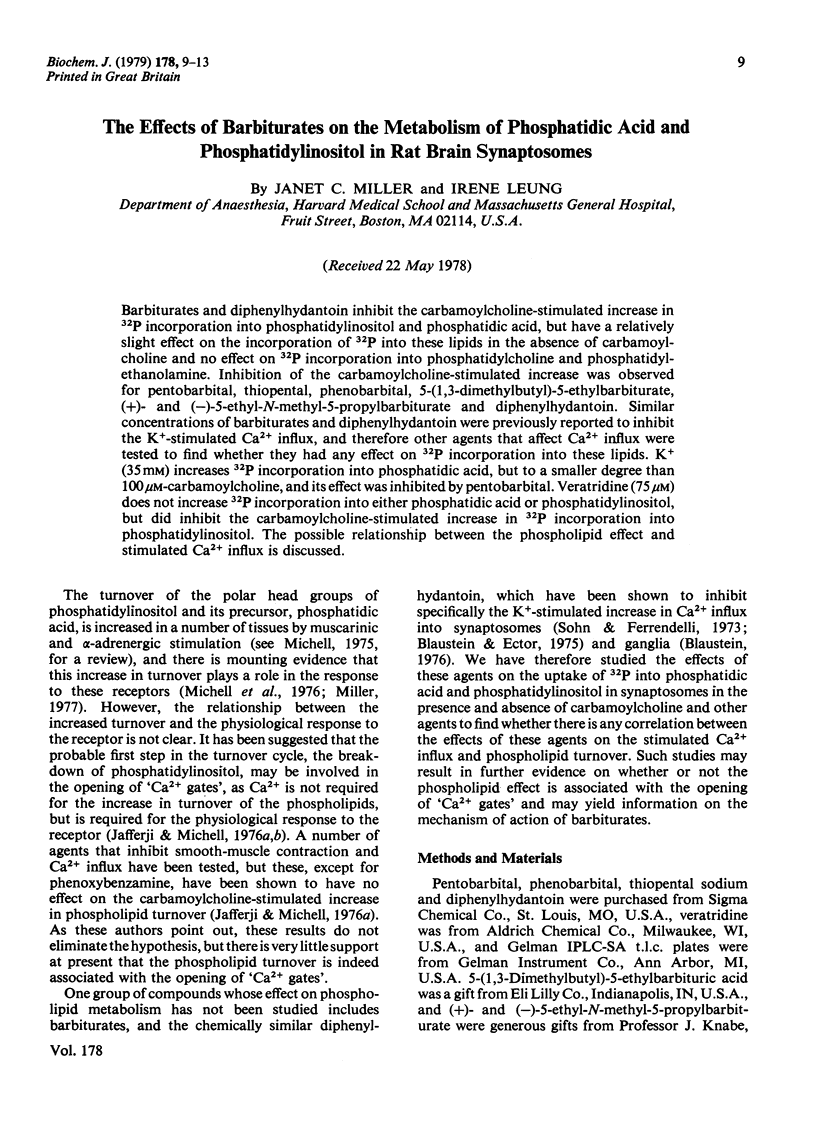
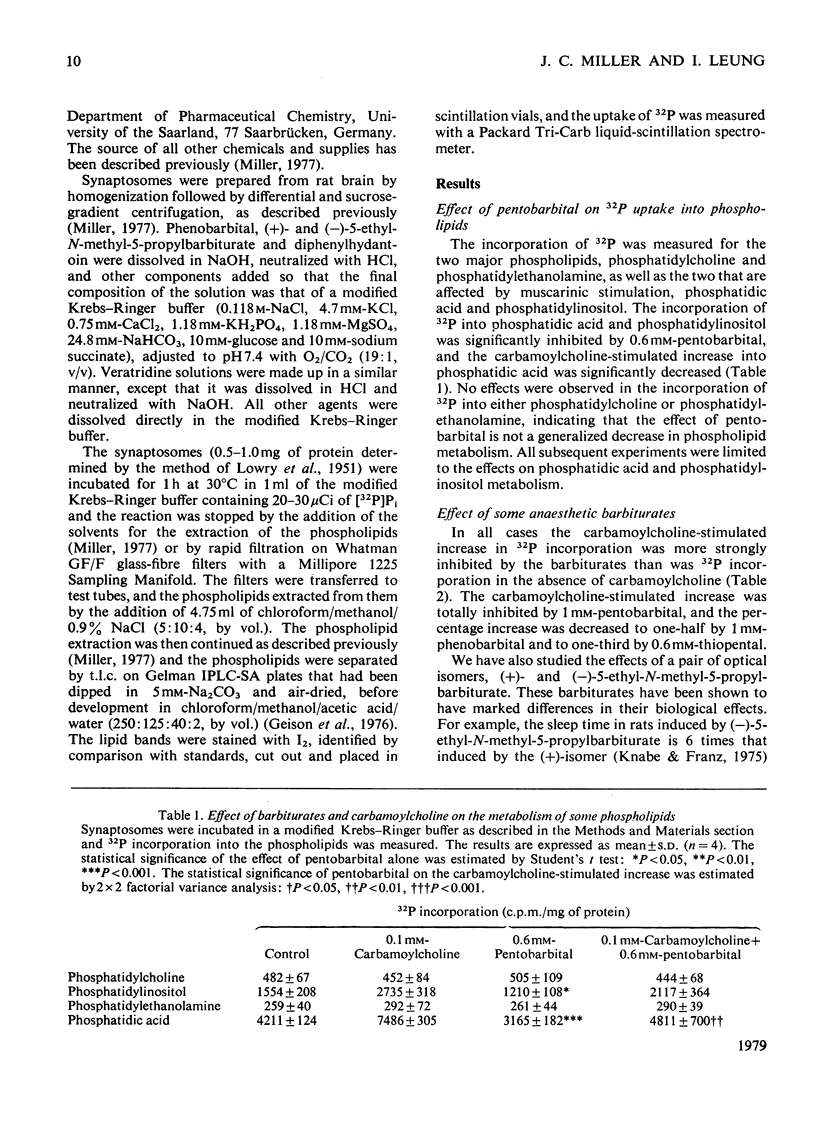
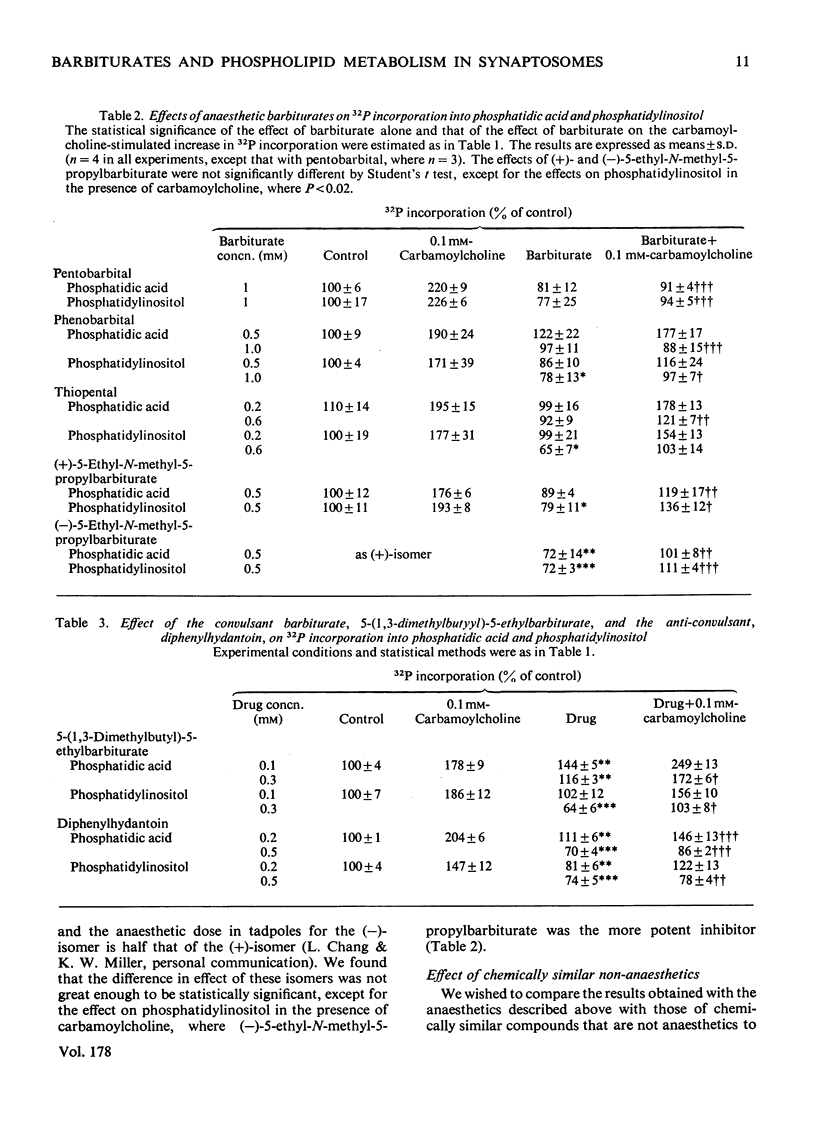
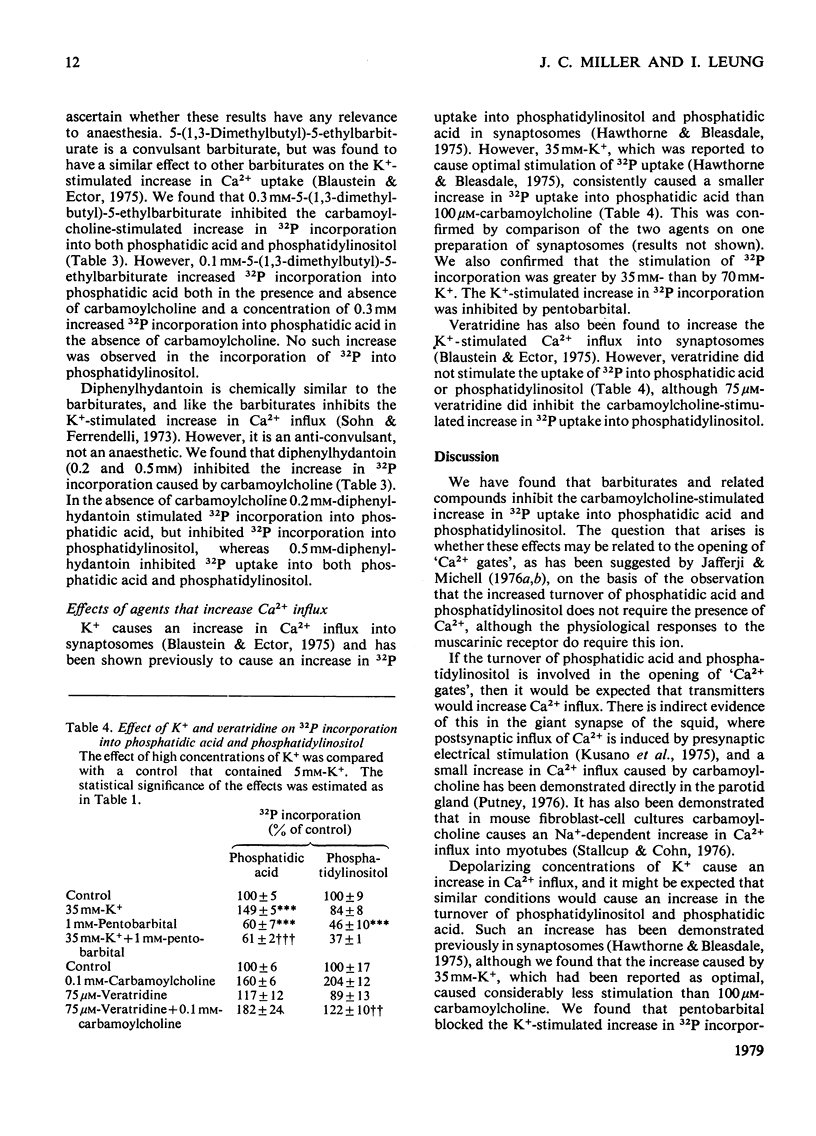
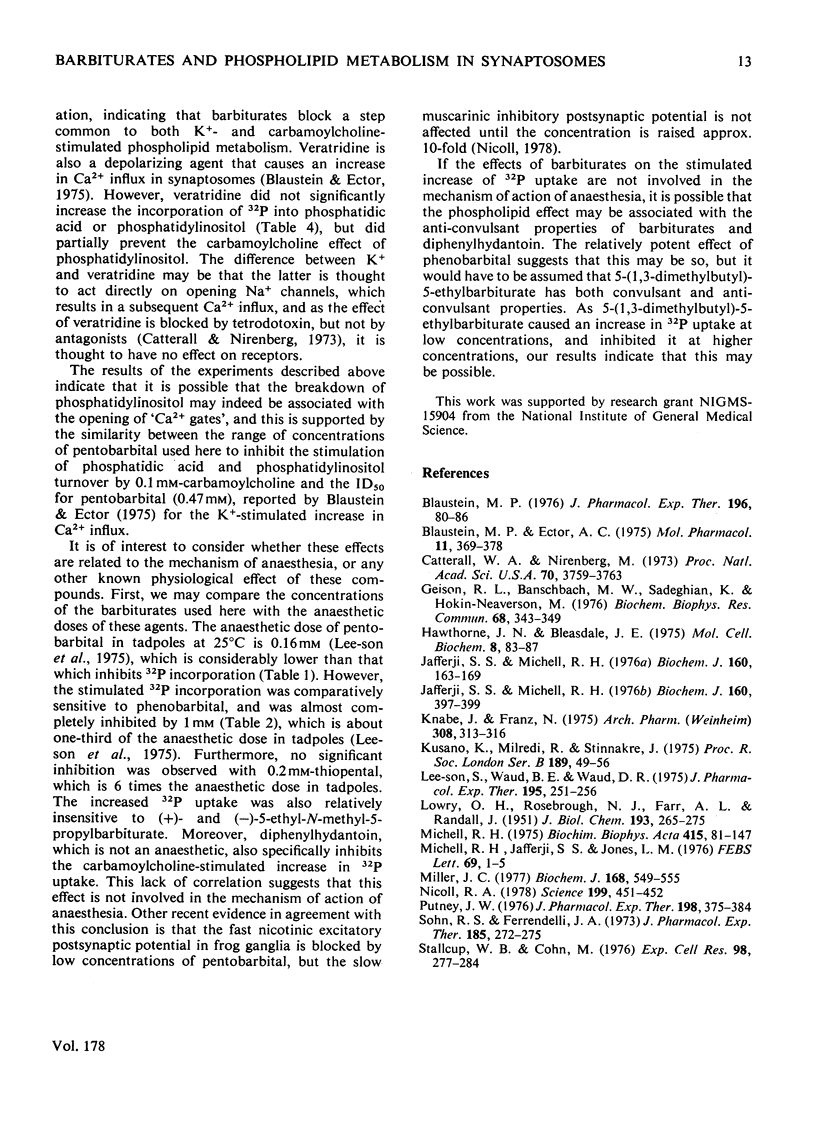
Selected References
These references are in PubMed. This may not be the complete list of references from this article.
- Blaustein M. P. Barbiturates block calcium uptake by stimulated and potassium-depolarized rat sympathetic ganglia. J Pharmacol Exp Ther. 1976 Jan;196(1):80–86. [PubMed] [Google Scholar]
- Blaustein M. P., Ector A. C. Barbiturate inhibition of calcium uptake by depolarized nerve terminals in vitro. Mol Pharmacol. 1975 May;11(3):369–378. [PubMed] [Google Scholar]
- Catterall W. A., Nirenberg M. Sodium uptake associated with activation of action potential ionophores of cultured neuroblastoma and muscle cells. Proc Natl Acad Sci U S A. 1973 Dec;70(12):3759–3763. doi: 10.1073/pnas.70.12.3759. [DOI] [PMC free article] [PubMed] [Google Scholar]
- Geison R. L., Banschbach M. W., Sadeghian K., Hokin-Neaverson M. Acetylcholine stimulation of selective increases in stearic and arachidonic acids in phosphatidic acid in mouse pancreas. Biochem Biophys Res Commun. 1976 Jan 26;68(2):343–349. doi: 10.1016/0006-291x(76)91149-9. [DOI] [PubMed] [Google Scholar]
- Hawthorne J. N., Bleasdale J. E. Phosphatidic acid metabolism, calcium ions and transmitter release from electrically stimulated synaptosomes. Mol Cell Biochem. 1975 Aug 30;8(2):83–87. doi: 10.1007/BF02116236. [DOI] [PubMed] [Google Scholar]
- Jafferji S. S., Michell R. H. Effects of calcium-antagonistic drugs on the stimulation by carbamoylcholine and histamine of phosphatidylinositol turnover in longitudinal smooth muscle of guinea-pig ileum. Biochem J. 1976 Nov 15;160(2):163–169. doi: 10.1042/bj1600163. [DOI] [PMC free article] [PubMed] [Google Scholar]
- Jafferji S. S., Michell R. H. Investigation of the relationship between cell-surface calcium-ion gating and phosphatidylinositol turnover by comparison of the effects of elevated extracellular potassium ion concentration on ileium smooth muscle and pancreas. Biochem J. 1976 Nov 15;160(2):397–399. doi: 10.1042/bj1600397. [DOI] [PMC free article] [PubMed] [Google Scholar]
- Knabe J., Franz N. Barbitursäurederivate, 19. Mitt. 5-Athyl-5-propyl-1N-methylbarbitursäure. Arch Pharm (Weinheim) 1975 Apr;308(4):313–316. doi: 10.1002/ardp.19753080412. [DOI] [PubMed] [Google Scholar]
- Kusano K., Miledi R., Stinnakre J. Postsynaptic entry of calcium induced by transmitter action. Proc R Soc Lond B Biol Sci. 1975 Apr 29;189(1094):49–56. doi: 10.1098/rspb.1975.0040. [DOI] [PubMed] [Google Scholar]
- LOWRY O. H., ROSEBROUGH N. J., FARR A. L., RANDALL R. J. Protein measurement with the Folin phenol reagent. J Biol Chem. 1951 Nov;193(1):265–275. [PubMed] [Google Scholar]
- Michell R. H. Inositol phospholipids and cell surface receptor function. Biochim Biophys Acta. 1975 Mar 25;415(1):81–47. doi: 10.1016/0304-4157(75)90017-9. [DOI] [PubMed] [Google Scholar]
- Michell R. H., Jafferji S. S., Jones L. M. Receptor occupancy dose--response curve suggests that phosphatidyl-inositol breakdown may be intrinsic to the mechanism of the muscarinic cholinergic receptor. FEBS Lett. 1976 Oct 15;69(1):1–5. doi: 10.1016/0014-5793(76)80640-0. [DOI] [PubMed] [Google Scholar]
- Miller J. C. A study of the kinetics of the muscarinic effect on phosphatidylinositol and phosphatidic acid metabolism in rat brain synaptosomes. Biochem J. 1977 Dec 15;168(3):549–555. doi: 10.1042/bj1680549. [DOI] [PMC free article] [PubMed] [Google Scholar]
- Nicoll R. A. Pentobarbital: differential postsynaptic actions on sympathetic ganglion cells. Science. 1978 Jan 27;199(4327):451–452. doi: 10.1126/science.202032. [DOI] [PubMed] [Google Scholar]
- Putney J. W., Jr Biphasic modulation of potassium release in rat parotid gland by carbachol and phenylephrine. J Pharmacol Exp Ther. 1976 Aug;198(2):375–384. [PubMed] [Google Scholar]
- Sohn R. S., Ferrendelli J. A. Inhibition of Ca ++ transport into rat brain synaptosomes by diphenylhydantoin (DPH). J Pharmacol Exp Ther. 1973 May;185(2):272–275. [PubMed] [Google Scholar]
- Stallcup W. B., Cohn M. Electrical properties of a clonal cell line as determined by measurement of ion fluxes. Exp Cell Res. 1976 Mar 15;98(2):277–284. doi: 10.1016/0014-4827(76)90439-0. [DOI] [PubMed] [Google Scholar]


